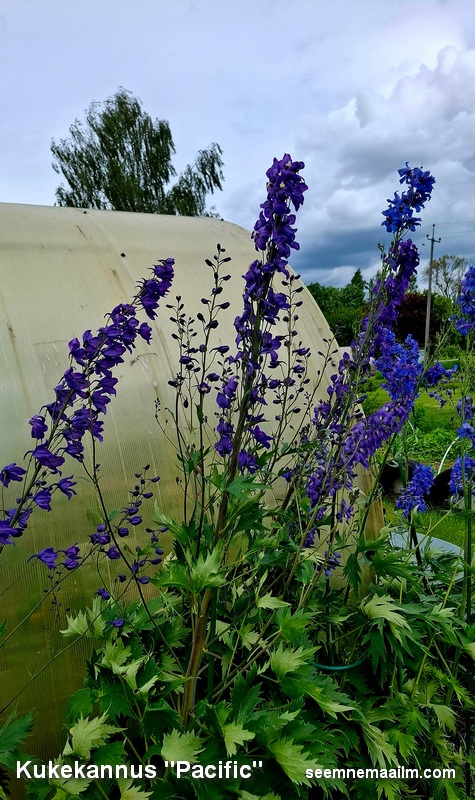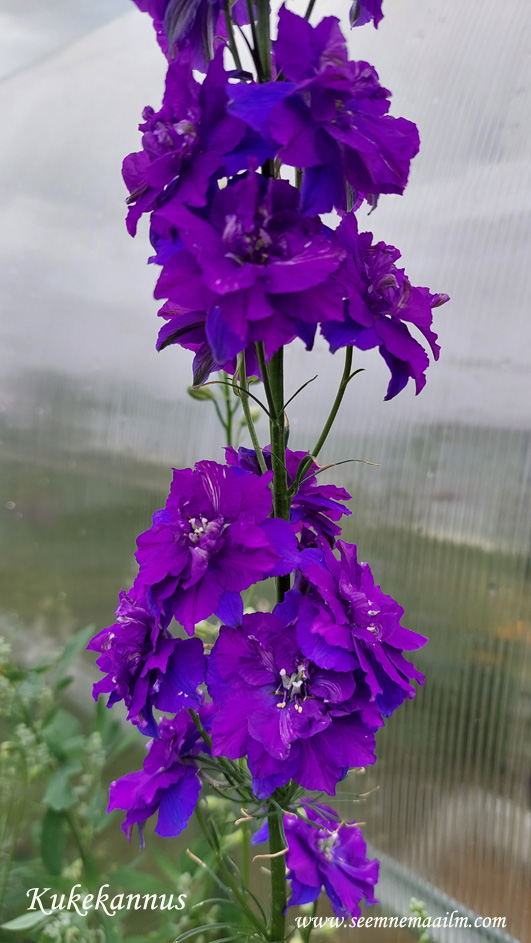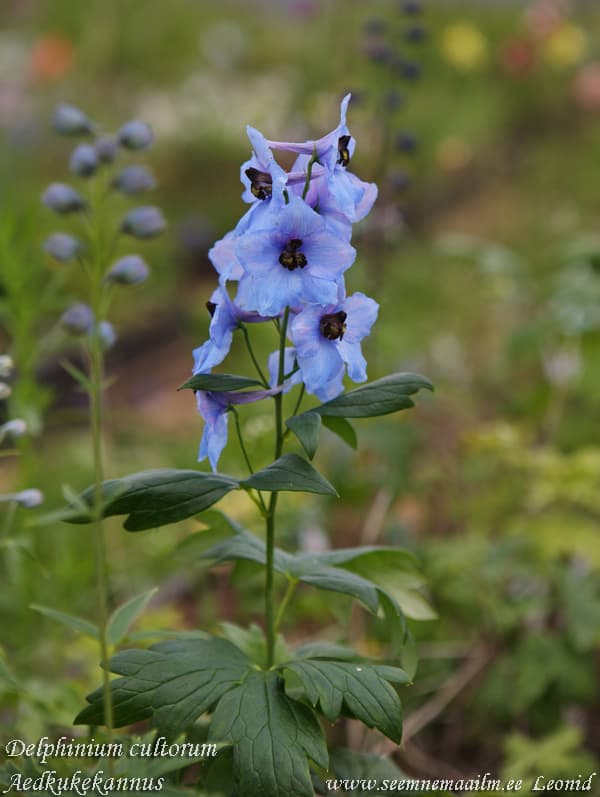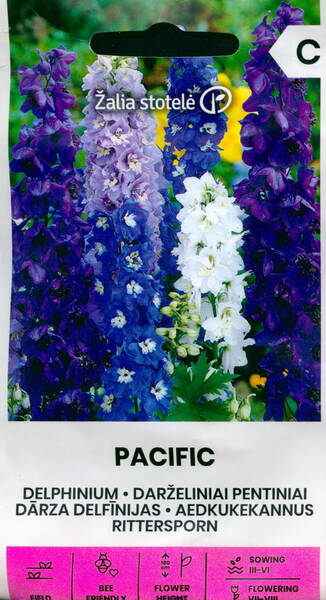Height up to 180 cm. Inflorescence diameter 3-4 cm.
1.0 g = 400-440 seeds.
PLANTING IN FLOWER BEDS.
The best time to plant delphiniums is late August or early September. The plants should be well established before frost. The distance between plants during planting depends on the variety and species. Tall hybrid delphiniums are planted 50-60 cm apart. The best planting location is considered to be shaded during midday hours, which helps preserve the vibrant color of the flowers.
In the designated planting area, dig holes up to 50 cm deep and 40 cm wide. Mix the excavated soil with humus and peat, adding mineral fertilizer (50 g per hole) and a handful of ash or lime. After preparation, return the soil to the hole, leaving a depression the size of the rhizome's diameter. When planting, the root collar with the renewal buds should be level with the soil surface. After planting, water the plants. If the weather is dry, repeat watering within a few days. Before the onset of frost, loosen the beds and remove weeds.



Alfred de Breanski.

PLANT CARE.
In spring, when the shoots reach 10-15 cm, delphiniums can be fed with mineral or liquid organic fertilizers. Usually, a solution of cow manure is used at the rate of: one bucket per 10 buckets of water, a bucket for five adult bushes. Mulching the soil with peat or humus has a very good effect on the development of plants. Mulch is scattered in a layer of 2-3 cm after removing weeds and loosening the soil. Thinning of bushes begins when the stems reach a height of 20-30 cm. Limiting the number of stems to three to five allows you to get larger inflorescences. Weak shoots are broken off at the very surface of the soil, where they connect to the root collar. First of all, shoots are removed from the inner part of the bush. This ensures good air circulation and protects plants from diseases. Instead of thinning the bushes in the spring, you can break off or cut off excess renewal buds in the fall. In this case, in the spring, all the nutrients will go directly to the remaining buds, which accelerates the development of stems and inflorescences.
When the plants are 40 ... 50 cm high, supports are installed. It is recommended to put at least three stakes up to 180 cm long on each plant. In order not to damage the rhizome, the stakes are driven in at some distance from the root collar. Fasteners made of a metal rod bent into a semicircle and fixed to posts driven into the ground are also very convenient. This method of fastening does not disturb the natural appearance of the plant.
The most vulnerable part of delphiniums is the junction of the stem with the rhizome. Therefore, the first garter is made at a height of 40 ... 50 cm. It is better to use narrow strips of cotton fabric as a garter material, since the twine can cut into the stem during the wind.
The second garter of the stems is made at a height of 100 ... 120 cm. Varieties with a massive inflorescence must be tied in the lower and even middle parts of the inflorescence, otherwise, under the influence of wind and rain, when a lot of water accumulates on the flowers, it can break. When planting delphiniums among shrubs that can provide support for the stems, the plants can be grown without the use of supports. During the growing season, each delphinium requires about 60 liters of water. During dry periods, 2 ... 3 buckets of water per week must be poured under each bush. Daily weak watering gives less benefit, since only the top layer of soil is moistened. After watering, when the soil dries out a little, loosening is carried out to a depth of 3 ... 5 cm. Delphiniums require a lot of water during the period of inflorescence formation. However, with extreme heat and an abundance of moisture, areas devoid of flowers may appear in the inflorescence. This is explained by the uneven growth of different parts of the inflorescence axis.
In some cases, "gaps in the brush" can be eliminated by feeding the plants with phosphorus-potassium fertilizers during the budding period. 20 g of fertilizer are diluted in one bucket of water and 1 liter is poured under each bush.
After flowering (if the purpose of collecting seeds is not pursued), the inflorescences are cut off. New shoots appear at the base of the old stems, and in the fall, the plants bloom a second time. However, during secondary flowering, renewal buds grow out and, in order for delphiniums to bloom well next year, it is recommended to leave the inflorescences and stem until the seeds ripen. Sometimes, to get larger inflorescences, all lateral branches are removed, although they extend the flowering period by two to three weeks.
In autumn, after the leaves have dried, the delphinium stem is cut off, leaving a stump 25...30 cm high. A high stump prevents water from penetrating through the stem cavity to the root collar, thereby protecting the rhizome from rotting. Especially a lot of water can get into the stem cavity in the spring when the snow melts, so it is sometimes covered with clay. Delphiniums tolerate winter well, and under a layer of snow they can withstand severe frosts. Young seedlings overwinter as well as adult plants. In the absence of snow cover, the beds should be covered with straw or spruce branches. Seedlings tolerate spring frosts down to -5...-6 °C without damaging the leaves.
Alternating frosts and thaws in late autumn or early spring can cause the death of delphiniums. Excess moisture during this period causes rotting of the rhizome. To protect against diseases, it is better to plant plants on ridges raised by 10-15 cm. It is recommended to add a shovel of clean river sand for each root collar.












